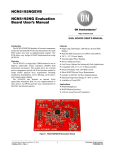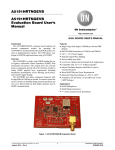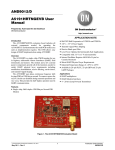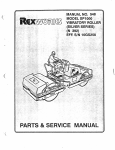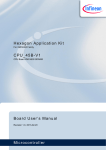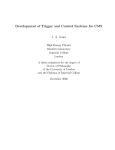Download EVBUM2237 - NCN5193NG Evaluation Board User's Manual
Transcript
NCN5193NGEVB NCN5193NG Evaluation Board User's Manual http://onsemi.com EVAL BOARD USER’S MANUAL Introduction Features The NCN5193NGEVB includes all external components needed for operating NCN5193 and demonstrates the small PCB surface area such an implementation requires. The EVB allows easy design of HART implementations using NCN5193. • Single-chip, Half-duplex 1200 bits per Second FSK • • • • • • • • • • • Overview The NCN5193 is a single-chip, CMOS modem for use in highway addressable remote transducer (HART) field instruments and masters. The modem and a few external passive components provide all of the functions needed to satisfy HART physical layer requirements including modulation, demodulation, receive filtering, carrier detect, and transmit-signal shaping. The NCN5193 also includes an internal 17-bit sigma-delta modulation DAC for easy implementation of slave devices. An SPI bus provides easy communication to this DAC and internal registers. Modem Bell 202 Shift Frequencies of 1200 Hz and 2200 Hz 1.8 V − 3.5 V Power Supply Transmit-signal Wave Shaping Receive Band-pass Filter Low Power: Optimal for Intrinsically Safe Applications Compatible with 1.8 V or 3.5 V Microcontroller Internal Oscillator with 3.68 MHz Crystal Meets HART Physical Layer Requirements Includes 17-bit DAC for Slave Implementation Industrial Temperature Range of −40°C to +85°C Available in 32-pin QFN Applications • HART Multiplexers • HART Modem Interfaces • 4-20 mA Loop Powered Transmitters Figure 1. NCN5193NGEVB Evaluation Board © Semiconductor Components Industries, LLC, 2014 May, 2014 − Rev. 0 1 Publication Order Number: EVBUM2237/D NCN5193NGEVB Table 1. ELECTRICAL CHARACTERISTICS OF THE NCN5193NGEVB BOARD Symbol VDD Characteristic Supply Voltage Min Typ Max Units 1.80 3.00 3.50 V Current Consumption IDD VDD = 1.80 V, idle − 170 − mA IDD VDD = 3.00 V, idle − 215 − mA IDD VDD = 3.50 V, idle − 240 − mA IDD External Clock, VDD = 1.80 V, idle − 130 − mA IDD External Clock, VDD = 3.50 V, idle − 180 − mA Transmitted Frequency fM Mark “1” − 1194 − Hz fS Space “0” − 2204 − Hz VTxA Amplitude Transmit Output − 500 − mV p-p VCD Carrier Detect Level − 110 − mV p-p AREF − 1.248 − V CDREF − 1.163 − V Levels Reference Voltages VAREF VCDREF Product parametric performance is indicated in the Electrical Characteristics for the listed test conditions, unless otherwise noted. Product performance may not be indicated by the Electrical Characteristics if operated under different conditions. NCN5193 Description Test and Measurement Tools The NCN5193 modem is a single-chip CMOS modem for use in HART field instruments and masters. It includes on-chip oscillator and a modulator and demodulator module communicating with a UART without internal buffer, as well as an internal 17 bit sigma delta DAC. The NCN5193 requires some external filter components and a 460.8 kHz, 921.6 kHz, 1.84 MHz or 3.68 MHz clock source. This clock source can either be the interface oscillator by using a crystal or ceramic resonator, or an external clock signal. When the device is transmitting data, the receive module is shut down and vice versa to conserve power. With simple power-saving maneuvers, the IC can be made to operate with a current consumption of as little as 130 mA. The same techniques apply as explained for the A5191HRT in the Design Note “A5191HRT Design for Low-Power Environments” (AND9030/D). Listed below are the tools used to acquire the values presented in this evaluation board. • Oscilloscope: Tektronix DPO4101 1 GHz • Signal Generator: Agilent 33250A http://onsemi.com 2 NCN5193NGEVB NCN5193NGEVB DESCRIPTION Schematic Diagram − BOM List Figure 2. NCN5193NGEVB Schematic http://onsemi.com 3 NCN5193NGEVB Table 2. NCN5193NGEVB BILL OF MATERIALS Reference Manufacturer & Comments Value Size Quantity C1, C5, C6, C10 100 nF 0603 4 C2, C3, C4 1 mF 0603 3 C7 C8, C9 Do Not Populate 1 nF 0603 1 DNP 0603 2 C11 470 pF 0603 1 C12 20 pF 0603 1 C13 200 pF 0603 1 C14 220 pF 0603 1 C15 330 pF 0603 1 IDC1, IDC2, IDC3, IDC4 R1, R3, R7, R8, R9, R13 IDC10 Do Not Populate 4 DNP 0603 6 R2, R4, R12 0R 0603 3 R5, R6, R24, R25 220 kW 0603 4 R10 14.7 kW 0603 1 R11 200 kW 0603 1 R14, R20 120 kW 0603 2 R15 2.2 MW 0603 1 R16 1.3 MW 0603 1 R17, R23 422 kW 0603 2 R18, R22 1.5 MW 0603 2 R19 270 kW 0603 1 R21, R26 806 kW 0603 2 174 kW 0603 1 R27 TP1, TP2, TP3, TP4, TP5 Do Not Populate DNP 5 U1 U2 ON Semiconductor NCN5193 1 Linear Technology LT1790−1.25 1 Y1 Murata CSTCC3M68G53−R0 1 General Overview The NCN5193NGEVB evaluation board demonstrates the external components required for the operation of the IC. We will cover the different sections below as well as possible alternatives. A drawing of the board where the different sections are indicated is shown below. Figure 3. Board Drawing with Indication of Different Sections http://onsemi.com 4 NCN5193NGEVB Power Supply and References Additional ferrite beads in series with power supply lines may help to reduce EMI. Power Supply The NCN5193NGEVB is designed for a nominal voltage of 3 V. However, NCN5193 can be operated with a power supply of 1.8 V to 3.5 V. Reference Voltages and Comparator Bias NCN5193 needs an external analog reference voltage. This reference is used by receiver or demodulator (RX) comparator, carrier detect (CD), and voltage supervisor. The AREF reference voltage sets the trip point of the demodulation operational amplifier of the NCN5193. The AREF reference voltage is also used in setting the DC operating point of the received signal after it has passed through the band-pass receive filter. The ideal value for the AREF reference voltage depends on the voltage supply, and is chosen roughly half-way the operating range of the operational amplifiers. This ensures the range of the operational amplifier is maximized. A reference voltage of 1.24 V is recommended. For NCN5193NGEVB, a series regulator is used with an internal reference of 1.25 V. The chosen regulator has a very low supply current, to optimize power usage. Using a series regulator is more desirable from a power usage perspective, as a series regulator’s current draw will vary with the output current, whereas a shunt regulator is dimensioned on the maximum current draw and will always draw the same current. Large capacitors on the in- and output of the voltage regulator increase the reference stability. The CDREF reference voltage sets the threshold for the carrier detect comparator. As the received signal is biased at AREF, the difference between CDREF and AREF will determine the minimum amplitude needed for the carrier detect comparator to flip. A (AREF-CDREF) of 80 mV corresponds to signal of approximately 100 mV peak-to-peak at the input of the receive filter. The CDREF reference voltage on the NCN5193NGEVB is generated by a resistor division of the AREF reference. An external resistor is required to set the bias current. The voltage over the bias resistor is regulated to AREF, so that the resistor determines a bias current. This bias current controls the operating parameters of the internal operational amplifiers and comparators and should be set to approximately 2.5 mA. For low cost solutions, a 470 kW is acceptable with minimal effect on operation. Figure 4. Supply Voltage and Power on Reset Current consumption of the module is very limited, making it ideal to be battery or loop-powered. Measurements of the power consumption of the module are listed in Table 1. The module will use less power when clock signal is applied externally, as this allows the modem to shut down the oscillator circuit. As is to be expected, a higher supply voltage increases current consumption. The NCN5193 includes an internal voltage supervisor. This will guarantee correct operation of the digital circuitry during start-up. All that is required for using this supervisor is an external resistor divider (R19, R20). The voltage supervisor compares the voltage offered by the resistor divider on the VPOR pin to AREF. The resistor divider should be dimensioned such that at the desired turn-on point of the voltage supervisor, the VPOR pin is equal to AREF. On the evaluation board the resistor divider is dimensioned to make the POR trip at 2.8 V. The voltage supervisor will keep the RESETB pin low until its threshold value is reached, and will then wait an additional minimum of 30 ms until it releases the RESETB. This ensures that some time has passed after the supply voltage reaches the turn-on voltage. C1 and C10 are 100 nF ceramic decoupling capacitors located directly adjacent to each power pin. For analog power pins, an additional large-value ceramic capacitor may be needed in addition to the 100 nF decoupling capacitor when the application is intended for high-noise environments. For loop-powered devices, additional decoupling with a large value capacitor is advised to prevent digital noise from being transmitted on the current loop. Table 3. REFERENCE VOLTAGES Description AREF Reference Voltage 1.248 V CDREF Reference Voltage 1.163 V http://onsemi.com 5 Value NCN5193NGEVB Figure 5. Reference Voltages Schematic Clock Generation NCN5193 is operated on a clock signal of either 460.8 kHz, 921.6 kHz, 1.84 MHz or 3.68 MHz. The NCN5193NGEVB has two options for providing this clock signal. The first method is by using a ceramic resonator or a crystal with the internal oscillator. The standard populated option is a Murata CSTCC3M68G53−R0 ceramic resonator, with build-in load capacitors. Alternatively, a clock signal can be provided externally when R12 is removed and R13 is populated by a resistor of 0 W. This signal can be provided by a microcontroller or any other external oscillator circuit. The module uses less power when clock signal is applied externally, as this allows the modem to shut down the oscillator circuit. A typical current consumption witnessed by utilizing an external oscillator is 60 mA less. However, care must be taken that this external signal has the required frequency accuracy (1%). Duty cycle of the clock signal is specified between 35% and 65%. Figure 6. Clock Generation Circuit (Resonator Option) Figure 7. Clock Generation Circuit (External Clock) UART Interface IDC3 Figure 8. UART Interface (IDC3) http://onsemi.com 6 NCN5193NGEVB Table 4. MICROCONTROLLER INTERFACE Pin Number Signal Type Description 1 RESETB Open Drain Reset Signal from the Voltage Supervisor, Open Drain with Pull-up, Active Low 3 CD Output 5 RxD Input 7 TxD Output Carrier Detect Receive from Microcontroller Transmit towards Microcontroller 9 RTSB Input 2, 10 VDD Power Request to Send, Active Low 3 V Nominal 4, 6, 8 GND Power Ground time base in another device is at 101% of nominal, the receive data (at the receiving UART) will be skewed by roughly 21% of one bit time at the end of each 11-bit byte. This is shown in Figure 9. The skew time is measured from the initial falling edge of the start bit to the center of the 11th bit cell. This 21% skew by itself is a relatively good result. However, there is another error source for bit boundary jitter. The Phase Lock Loop demodulator in the NCN5193 produces jitter in the receive data that can be as large as 12% of a bit time. Therefore, a bit boundary can be shifted by as much as 24% of a bit time relative to its ideal location based on the start-bit transition. (The start-bit transition and a later transition can be shifted in opposite directions for a total of 24%). The clock skew and jitter added together is 45%, which is the amount that a bit boundary could be shifted from its expected position. UARTs that sample at mid-bit will not be affected. However, there are UARTs that take multiple samples during each bit to try to improve on error performance. These UARTs may not be satisfactory, depending on how close the samples are to each other, and how samples are interpreted. A UART that takes a majority vote of 3 samples is acceptable. Even if your own time base is perfect, you still must plan on a possible 35% shift in a bit boundary, since you don’t have control over time bases in other HART devices. The interface towards a microcontroller is provided in IDC3. This interface can also be used to supply power to the module. The nominal supply voltage for the module is 3 V. For more information see the section on power supply and references. The RESETB line to the modem is an open drain signal. A pull-up resistor of 220 kW is provided on the board, and should not be duplicated on the microcontroller side. The reset signal is generated on the board, and could be used as reset signal for other IC such as the microcontroller. The CD signal rises when a HART signal of ca. 100 mVpp is detected on the current loop. See the section on reference voltages for more information on these threshold level settings. When no signal, or a signal of limited amplitude is present, the CD line is pulled down to 0 V. The RxD, TxD, and RTSB signals implement a standard UART interface at 1200 baud with start bit, 8 data bits, parity bit and stop bit (11-bit frame). The RTSB signal disconnects the transmitter circuit when pulled high, and should be held low before any data is transmitted. Data frames are not buffered by the modem. Instead, data is transmitted bit by bit. Care should be taken to avoid clock skew in the receiving UART. If the same time base is used for both the modem and the UART, a 1% accurate time base may not be sufficient. The problem is a combination of receive data jitter and clock skew between transmitting and receiving HART devices. If the transmit time base is at 99% of nominal and the receive Figure 9. Clock Skew http://onsemi.com 7 NCN5193NGEVB SPI Interface and Internal Register The NCN5193 also has an SPI interface that is used to control the integrated DAC and set the configuration registers of the IC. This interface is accessible on the evaluation board through connector IDC1. Figure 10. SPI Interface (IDC1) Table 5. SPI/DAC INTERFACE Pin Number Signal Type Description 5 DAC Output DAC Output 4 CLK Input SPI Clock 6 DATA Input SPI Data in (MOSI) SPI Chip Select 8 CS Input 1, 2, 3, 7, 9 GND Power 10 CLK2 Output Clock Output 2 sufficiently decoupled from the power supply, such as by a large-value ceramic capacitor (1 mF typical). The switching output signal will have the desired DC (low frequency) component, but also includes a lot of switching noise that needs to be filtered out before the signal is useful. This means that an output low pass filter is required before the DAC output can be used. Since the sigma-delta modulator is designed for a bandwidth of 25 Hz, it is advised that the corner frequency of the output filter is placed on this frequency. For more information on how to design this filter, see the section on slave implementation. To achieve maximum accuracy of the DAC, it is also advised to use a separate, low-noise reference as DACREF instead of tying this pin to VDD, and to keep the DAC line away from noisy signal lines. At reset of the device, all bits of the internal register are set to their reset value. This means that, before being able to use the evaluation board, the device must be configured and all required blocks must be turned on. See the description of the internal registers in the NCN5193 datasheet for more information. Internal Sigma-Delta DAC Transmitter The TxA modem pin is accessible through pin 7 of IDC2. For certain applications, it might be required to couple the transmit signal in the circuit by adding a series capacitor. Note that this is a difference with the A5191HRTNEVB, where this coupling capacitor was provided on the board. The output on this pin is a 500 mVpp signal trapezoid waveform shown in figure 11. This pin can only drive impedances higher than 30 kW, and as a consequence may need to be amplified. The nominal frequency of the output is 1200 Hz for “mark” and 2200 Hz for “space”. These frequencies are dependent on the accuracy of the NCN5193 clock. Figure 11. DAC Interface The NCN5193 includes an internal DAC that can be used for the implementation of a slave analog transmitter. The included DAC has a Sigma-Delta topology. This means that the output of the DAC is constantly switching between 0 V en DACREF (3 V on the evaluation board). To achieve optimum accuracy, it is required that DACREF is http://onsemi.com 8 NCN5193NGEVB Figure 12. Output Waveform (Mark) Figure 13. Output Waveform (Space) http://onsemi.com 9 NCN5193NGEVB Receiver The receive band pass filter is implemented on the NCN5193NGEVB. The values are listed in Table 6 and the filter schematic is displayed in Figure 14. This is a band pass filter based on a Sallen-Key topology allowing only frequencies around the HART signal frequencies to pass through. For a more detailed description of the filter see the user manual of A5191HRTNEVB. Table 6. RECEIVE FILTER COMPONENT VALUES Figure 14. Receive Filter http://onsemi.com 10 Reference Value R15 2.2 MW, 1% R16 1.3 MW, 1% R17, R23 422 kW, 1% R18, R22 1.5 MW, 1% R21, R26 806 kW, 1% R27 174 kW, 1% C7 1 nF, 5% C11 470 pF, 5% C12 20 pF, 5% C13 200 pF, 5% C14 220 pF, 5% C15 330 pF, 5% NCN5193NGEVB APPLICATION IDEAS explain the operation of this circuit, let us first look at an example where the DAC is not of a switching topology, such as shown in Figure 15. As one end of R6 is tied to local ground, and current passing through R7 also passes through R6, it can easily be seen that the voltage at the negative loop terminal is negative with respect to the local ground. Resistor R4 is then chosen so that in steady state their common terminal is a virtual ground point in the absence of HART signals, since the negative terminal of the amplifier is also connected to ground. A similar principle applies when HART signals are applied. So both amplifier inputs are regulated to ground. The NCN5193 takes care of generating the HART modulation. This HART signal must then be superimposed on a 4−20 mA current loop. The NCN5193 simplifies slave implementation by including an integrated DAC. Below are some possible implementations of both a master and slave transmitter. Slave Implementation A simple slave implementation is shown in Figure 16. The analog loop current is set by the integrated DAC, and HART signals are added to this by a resistive summing network. The DAC is implemented as a sigma-delta modulator, which means that additional filtering should be implemented. To Figure 15. Simple Slave Implementation A compensation capacitor C4 may be required depending on the operational amplifier used. To avoid offset generated by bias current in the operational amplifier, a resistor R3 should be placed on the negative input, and dimensioned to approach the impedance seen by the positive terminal. The amplifier will then determine the current flowing through the loop by changing the base of a transistor in emitter feedback configuration. The value for R7 is determined by the output range Vo,max of the amplifier used: R 7, max + Where: Z+ ŤsC1 ) R Ť 1 1 In practice, C1 is chosen sufficiently large so that Z ≈ R1. Because the integrated DAC has a sigma-delta output, a circuit using the NCN5193 gets a bit more complicated, as can be seen in Figure 16. We need to filter away high frequency DAC components, but leave HART signals intact. A simple RC-filter is not sufficient, since the output capacitor has low impedance for HART frequencies. We can do this by replacing the summing resistor R4 by a T-filter. This filter has high output impedance due to the output resistor. To dimension this filter without too much calculation, we can treat it as a RC-filter using its first branch. The 3-dB frequency should be placed just above the DAC bandwidth (10 Hz). We get, with R4 ≈ R5: V o, max * V BE 20 mA It is often recommended to take a value as large as possible, so that noise effects are minimal. Typically the value of R6 is chosen equal to R7. The voltage over R6 and R7 combined should however be less than 12 V when the current setting is 20 mA. Next, the value of R4 is chosen depending on the most significant bit of the DAC. 2 V MSB R 2 + 20 mA R 6 R 4 f 3dB + When the DAC is not a switching topology, we can now choose R1 and C1. We have: 500 mV R 2 + 1 mA R 6 Z http://onsemi.com 11 1 2p C 3 R 4 NCN5193NGEVB To dimension the summing resistor of the HART input, we can no longer assume that the positive input of the amplifier is a virtual ground, as this assumption is only valid for DC signals. We can, however, find a relationship between input amplitude and output amplitude. We know that the positive amplifier input voltage has the following form, due to the summing network: ǒR V out + Reconfiguring for the unknown R1: R1 + Ǔ R R 2ǒR 4 ) R 5ǓV in ) V outǒR 2 ) R 3Ǔ V outǒ1 ) ǒR 4 ) R 5ǓǓ The amplifier is configured as an integrator for low frequencies. Care must be taken that the 3-dB frequency of the integrator is below the HART band, so that the amplifier gain in that band is independent of frequency. The resistor R3 is chosen so that it compensates for input bias current. This is achieved by taking a value close to the resistance seen on the positive terminal. This means that the capacitor C2 needs to be chosen so that (2 p R3C2)−1 < 1 kHz. V V V ) + ǒR 1ńńR 2ńńǒR 4 ) R 5ǓǓ in * out 1 ǒR 1ńńR 2ńńǒR 4 ) R 5ǓǓ R2 V R 1 ǒR 1ńńR 2ńńǒR 4 ) R 5ǓǓ ) R 2 in 2 The amplifier is configured as an integrator for low frequencies, but for high frequencies, the amplifier configuration has a gain of 1, and the transistor is configured as a voltage follower, so we can conclude that for AC frequencies V+ = Vout. Taking this into account, we get the following equation: Figure 16. Sample Slave Implementation Master Implementation An example of a possible master implementation is shown in Figure 17. The current loop master has a sense resistor over which the current flowing through the loop can be measured. The value of this resistor varies depending on the sensitivity required and range of the ADC. A HART Master can have a sense resistor ranging from 230 W to 600 W. Increasing the sense resistor will result in higher amplitude HART signal received, but will also reduce the voltage available on the slave side. Furthermore, if you wish to sense the analog transmitted signal, the MSB of your DAC may limit the resistor size. If this limitation is too stringent, the sense resistor can be split in two resistors, as shown in the figure, effectively creating a resistor divider. To transmit a HART signal, the TxA signal will need to be amplified, as the NCN5193 transmit circuit can only drive high impedance circuits (> 30 kW). An additional operational amplifier is required. Depending on the sense resistor used, some gain or attenuation may be required to get a 1 mA peak-to-peak HART output signal. This can be accomplished by the resistors R3 and R4. For a typical sense resistor of 500 W, a unity gain suffices and a unity gain operational amplifier configuration can be used instead. The amplifier however has a low impedance output, which cannot be paralleled with the sense resistor, as this would cause problems when the slave is transmitting. This problem is solved by adding a series switch (such as MC74VHC1G66DTT1G), controlled by the RTS signal. For a normally open switch, the nRTS signal as applied to the NCN5193 must be inverted first. To reduce power usage, the operational amplifier can be disabled when the transmitter is turned off. This is both done by inserting PNP transistor Q1on the VDD connection of the amplifier. To couple the signal into the current loop, a single capacitor was used. For other coupling techniques see application note AND8346/D. http://onsemi.com 12 NCN5193NGEVB Figure 17. Sample Master Implementation http://onsemi.com 13 NCN5193NGEVB APPENDIX Evaluation Board Layout Figure 18. Top Layer Layout Figure 19. Bottom Layer Layout ON Semiconductor and are registered trademarks of Semiconductor Components Industries, LLC (SCILLC). SCILLC owns the rights to a number of patents, trademarks, copyrights, trade secrets, and other intellectual property. A listing of SCILLC’s product/patent coverage may be accessed at www.onsemi.com/site/pdf/Patent−Marking.pdf. SCILLC reserves the right to make changes without further notice to any products herein. SCILLC makes no warranty, representation or guarantee regarding the suitability of its products for any particular purpose, nor does SCILLC assume any liability arising out of the application or use of any product or circuit, and specifically disclaims any and all liability, including without limitation special, consequential or incidental damages. “Typical” parameters which may be provided in SCILLC data sheets and/or specifications can and do vary in different applications and actual performance may vary over time. All operating parameters, including “Typicals” must be validated for each customer application by customer’s technical experts. SCILLC does not convey any license under its patent rights nor the rights of others. SCILLC products are not designed, intended, or authorized for use as components in systems intended for surgical implant into the body, or other applications intended to support or sustain life, or for any other application in which the failure of the SCILLC product could create a situation where personal injury or death may occur. Should Buyer purchase or use SCILLC products for any such unintended or unauthorized application, Buyer shall indemnify and hold SCILLC and its officers, employees, subsidiaries, affiliates, and distributors harmless against all claims, costs, damages, and expenses, and reasonable attorney fees arising out of, directly or indirectly, any claim of personal injury or death associated with such unintended or unauthorized use, even if such claim alleges that SCILLC was negligent regarding the design or manufacture of the part. SCILLC is an Equal Opportunity/Affirmative Action Employer. This literature is subject to all applicable copyright laws and is not for resale in any manner. PUBLICATION ORDERING INFORMATION LITERATURE FULFILLMENT: Literature Distribution Center for ON Semiconductor P.O. Box 5163, Denver, Colorado 80217 USA Phone: 303−675−2175 or 800−344−3860 Toll Free USA/Canada Fax: 303−675−2176 or 800−344−3867 Toll Free USA/Canada Email: [email protected] N. American Technical Support: 800−282−9855 Toll Free USA/Canada Europe, Middle East and Africa Technical Support: Phone: 421 33 790 2910 Japan Customer Focus Center Phone: 81−3−5817−1050 http://onsemi.com 14 ON Semiconductor Website: www.onsemi.com Order Literature: http://www.onsemi.com/orderlit For additional information, please contact your local Sales Representative EVBUM2237/D














